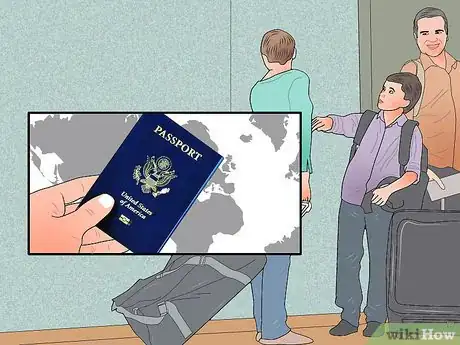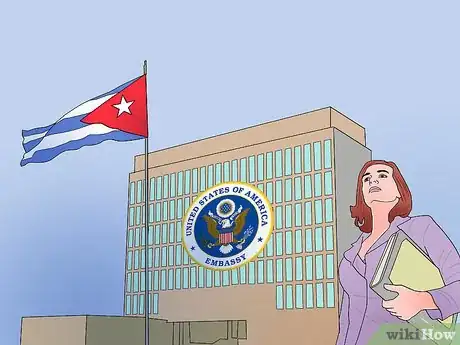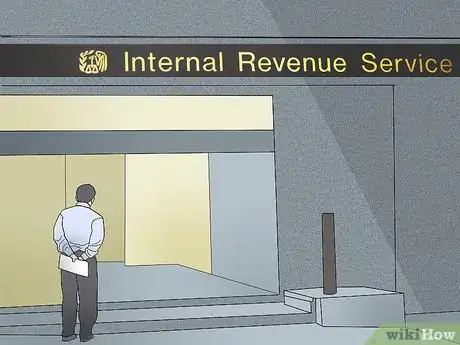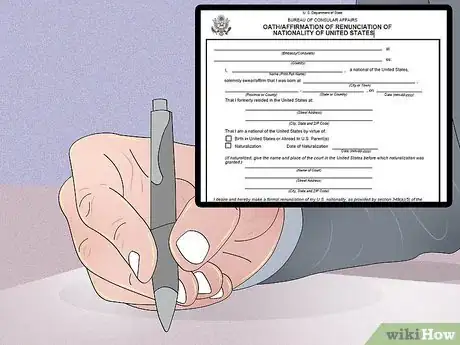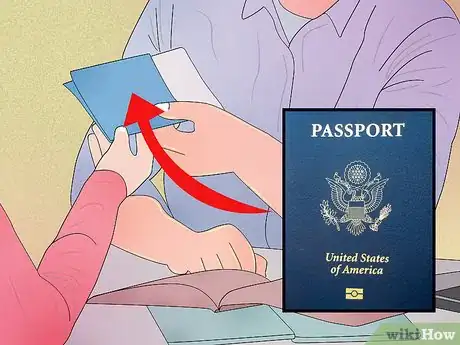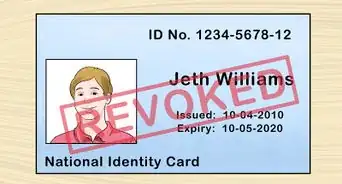This article was co-authored by Clinton M. Sandvick, JD, PhD. Clinton M. Sandvick worked as a civil litigator in California for over 7 years. He received his JD from the University of Wisconsin-Madison in 1998 and his PhD in American History from the University of Oregon in 2013.
This article has been viewed 62,702 times.
If you're thinking of renouncing your American citizenship, you should know that statistics show more and more people doing so in recent years.[1] Be aware that the process can be long, but thousands still choose to do it every year.[2] If you're considering renouncing your U.S. citizenship, be sure you know what's involved.
Steps
Getting Started
-
1Consider the consequences of renouncing your citizenship. Renouncing your citizenship is a monumental decision, so you should be aware of all the potential drawbacks before proceeding. They include, but aren't limited to the following.[3]
- You won't be able to travel freely back to the US. You'll have to apply for permission at an embassy before entering the country. Citizens of some countries are exempt from this restriction under the Visa Waiver Program. This allows citizens of some countries to stay in the US for up to 90 days without obtaining a visa.
- You won't be under the protection of the US government while traveling abroad.
- You won't be able to work in the US anymore.
-
2Obtain citizenship in another country. It is very important to obtain citizenship in another country before renouncing your US citizenship. If you renounce your US citizenship first, you'll end up stateless, which means you're not associated with any government. This means you won't be able to work, get a bank account, go to school, and many other drawbacks. To avoid this outcome, it's very important that you obtain dual citizenship before renouncing your US citizenship.[4]
- Read Obtain Dual Citizenship for instructions on applying for citizenship in another country.
- If you obtain citizenship from another country with the intention of losing your American citizenship, your American citizenship is relinquished, but it is harder to prove relinquishment than renunciation.
Advertisement -
3Move to another country. You can't renounce your US citizenship from inside the US. It must be done from a US embassy in another country. Travel to the country that you intend on becoming a citizen of to begin the process of renouncing citizenship.[5]
-
4Contact the IRS to see if you have tax obligations. Be aware that renouncing your citizenship does not cancel out your tax obligations if you owe back taxes. If you fail to meet your tax obligations, you could become a fugitive. Since the US has extradition treaties with many countries, fleeing the country won't stop you from being arrested. Settle any tax matters before you renounce citizenship.[6]
-
5Gather the renunciation fee. Due to a large number of Americans renouncing citizenship, the State Department has increased the renunciation fee in recent years. It now stands at $2,350. Make sure you have this fee ready for when you go to renounce your citizenship.[7]
Renouncing Your Citizenship
-
1Find the nearest US embassy. Once you get to another country, then you can officially start the process of renunciation. You have to renounce your citizenship in front of a US diplomatic officer, so you'll need to find the nearest American embassy.[8]
- Click here to locate an embassy or consulate near you.
- It would be helpful to contact the embassy before you visit to find out if you need to make an appointment or bring anything with you.
-
2Appear before a diplomatic officer. You have to appear in person to renounce your citizenship; it cannot be done through the mail or a mediator. Once you're at the embassy, you'll have to verbally state your intention to renounce US citizenship in front of a diplomatic officer.[9]
-
3Sign the oath of renunciation. After you meet with the diplomatic officer, he will present you with an oath renouncing your citizenship. Read this document carefully and consider your decision before signing it. After you sign the document, there is no going back.[10]
-
4Turn in your US passport. Once you're no longer a US citizen, you can't use your US passport anymore. You'll have to turn this in when you renounce your citizenship.[11]
Warnings
- Renunciation, with very limited exceptions, is irreversible. Once you renounce your citizenship it will be very difficult if not impossible to reacquire it.⧼thumbs_response⧽
- If you renounce your citizenship without first gaining citizenship in another country, you will be stateless.⧼thumbs_response⧽
References
- ↑ http://www.forbes.com/sites/robertwood/2015/05/08/new-un-american-record-renouncing-u-s-citizenship/
- ↑ http://www.moodysgartner.com/renouncing-your-u-s-citizenship-is-divorcing-uncle-sam-right-for-you/?utm_source=Mondaq&utm_medium=syndication&utm_campaign=View-Original
- ↑ http://www.moodysgartner.com/renouncing-your-u-s-citizenship-is-divorcing-uncle-sam-right-for-you/?utm_source=Mondaq&utm_medium=syndication&utm_campaign=View-Original
- ↑ https://travel.state.gov/content/travel/en/legal/travel-legal-considerations/us-citizenship/Renunciation-US-Nationality-Abroad.html
- ↑ https://travel.state.gov/content/travel/en/legal/travel-legal-considerations/us-citizenship/Renunciation-US-Nationality-Abroad.html
- ↑ https://travel.state.gov/content/travel/en/legal/travel-legal-considerations/us-citizenship/Renunciation-US-Nationality-Abroad.html
- ↑ https://www.federalregister.gov/articles/2014/08/28/2014-20516/schedule-of-fees-for-consular-services-department-of-state-and-overseas-embassies-and#p-amd-2
- ↑ https://travel.state.gov/content/travel/en/legal/travel-legal-considerations/us-citizenship/Renunciation-US-Nationality-Abroad.html
- ↑ https://travel.state.gov/content/travel/en/legal/travel-legal-considerations/us-citizenship/Renunciation-US-Nationality-Abroad.html
About This Article
To renounce your American citizenship, first move to your new country and take whatever steps are necessary to get citizenship there. Once you’ve secured new citizenship, find the nearest U.S. Embassy. Before you go, call to make an appointment and find out what documents to bring with you. When you show up for your appointment, be ready to make your renunciation verbally and in writing. After you turn in your passport you’re done! For more from our Legal reviewer on carefully thinking through this decision, continue reading.
